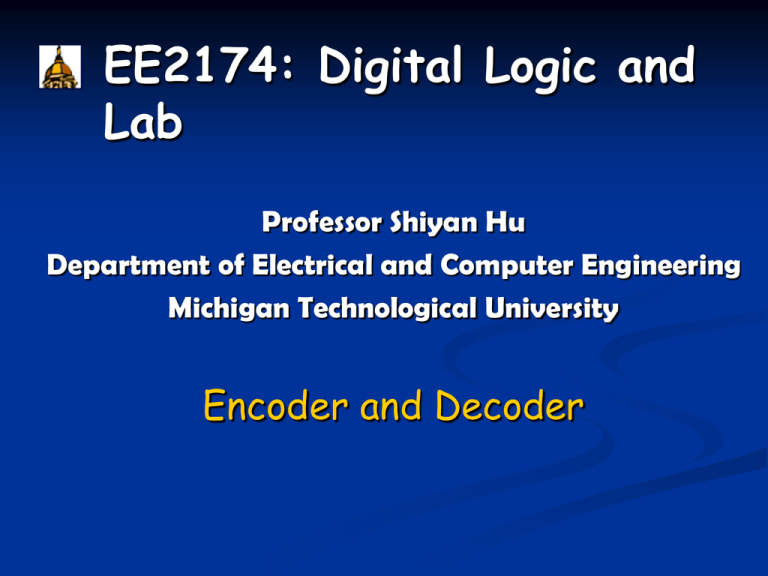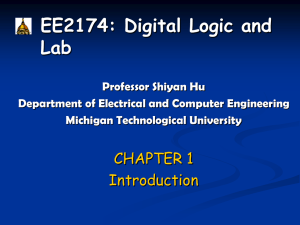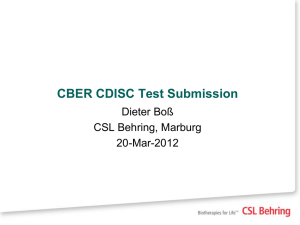PPT - Electrical and Computer Engineering
advertisement

EE2174: Digital Logic and Lab Professor Shiyan Hu Department of Electrical and Computer Engineering Michigan Technological University Encoder and Decoder Overview of Encoder and Decoder MUX Gate Rudimentary functions Binary Decoders 13-Apr-15 Expansion Circuit implementation Binary Encoders Priority Encoders PJF - 2 Multiplexer “Selects” binary information from one of many input lines and directs it to a single output line. Also know as the “selector” circuit, Selection is controlled by a particular set of inputs lines whose # depends on the # of the data input lines. For a 2n-to-1 multiplexer, there are 2n data input lines and n selection lines whose bit combination determines which input is selected. 13-Apr-15 PJF - 3 Combinational Logic Multiplexer (cont.) 13-Apr-15 PJF - 4 Combinational Logic 2-to-1-Line Multiplexer Since 2 = 21, n = 1 The single selection variable S has two values: S = 0 selects input I0 S = 1 selects input I1 The equation: Y = S’ I0 + SI1 The circuit: Enabling Circuits Decoder I0 Y S 13-Apr-15 PJF - 5 I1 Combinational Logic Example: 4-to-1 MUX using Cell Library Based Design 13-Apr-15 PJF - 6 Combinational Logic 4–to–1-Line Multiplexer using Transmission Gates 13-Apr-15 PJF - 7 Combinational Logic MUX as a Universal Gate We can construct AND and NOT gates using 2-to-1 MUXs. Thus, 2-to-1 MUX is a universal gate. z = 0x + 1x’ = x’ 13-Apr-15 Combinational Logic z = x1x0 + 0x0’ = x1x0 PJF - 8 Multiple Bit Selection Until now, we have examined single-bit data selected by a MUX. What if we want to select m-bit data/words? Combine MUX blocks in parallel with common select and enable signals Example: Construct a logic circuit that selects between 2 sets of 4-bit inputs (see next slide for solution). 13-Apr-15 PJF - 9 Example: Quad 2-to-1 MUX Uses four 4-to-1 MUXs with common select (S) and enable (E). Select line chooses between Ai’s and Bi’s. The selected fourwire digital signal is sent to the Yi’s Enable line turns MUX on and off (E=1 is on). 13-Apr-15 PJF - 10 Implementing Boolean functions with Multiplexers Any Boolean function of n variables can be implemented using a 2n-1-to-1 multiplexer. A MUX is basically a decoder with outputs ORed together, hence this isn’t surprising. The SELECT signals generate the minterms of the function. The data inputs identify which minterms are to be combined with an OR. 13-Apr-15 PJF - 11 Example •F(X,Y,Z) = X’Y’Z + X’YZ’ + XYZ’ + XYZ = Σm(1,2,6,7) •There are n=3 inputs, thus we need a 22-to-1 MUX •The first n-1 (=2) inputs serve as the selection lines 13-Apr-15 PJF - 12 Efficient Method for implementing Boolean functions For an n-variable function (e.g., f(A,B,C,D)): Need a 2n-1 line MUX with n-1 select lines. Enumerate function as a truth table with consistent ordering of variables (e.g., A,B,C,D) Attach the most significant n-1 variables to the n-1 select lines (e.g., A,B,C) Examine pairs of adjacent rows (only the least significant variable differs, e.g., D=0 and D=1). Determine whether the function output for the (A,B,C,0) and (A,B,C,1) combination is (0,0), (0,1), (1,0), or (1,1). Attach 0, D, D’, or 1 to the data input corresponding to (A,B,C) respectively. 13-Apr-15 PJF - 13 The Other Example Consider F(A,B,C) = m(1,3,5,6). We can implement this function using a 4-to-1 MUX as follows. The index is ABC. Apply A and B to the S1 and S0 selection inputs of the MUX (A is most sig, S1 is most sig.) Enumerate function in a truth table. 13-Apr-15 PJF - 14 MUX Example (cont.) A B C F 0 0 0 0 0 0 1 1 0 1 0 0 0 1 1 1 When A=1, B=0, F=C 1 0 0 0 1 0 1 1 When A=B=1, F=C’ 1 1 0 1 1 1 1 0 When A=B=0, F=C When A=0, B=1, F=C 13-Apr-15 PJF - 15 MUX implementation of F(A,B,C) = m(1,3,5,6) B A C C C F C’ 13-Apr-15 PJF - 16 A larger Example 13-Apr-15 PJF - 17 Rudimentary Functions 13-Apr-15 PJF - 18 Selection 13-Apr-15 PJF - 19 Enabling “gating” ? 13-Apr-15 PJF - 20 The Other Code Converter BCD-to-Seven-Segment Converter Seven-segment display: 7 LEDs (light emitting diodes), each one controlled by an input a 1 means “on”, 0 means “off” f b Display digit “3”? g Set a, b, c, d, g to 1 Set e, f to 0 e c d 13-Apr-15 PJF - 21 BCD-to-Seven-Segment Converter Input is a 4-bit BCD code 4 inputs (w, x, y, z). Output is a 7-bit code (a,b,c,d,e,f,g) that allows for the decimal equivalent to be displayed. a Example: f Input: 0000BCD Output: 1111110 (a=b=c=d=e=f=1, g=0) g 13-Apr-15 e b c d PJF - 22 BCD-to-Seven-Segment (cont.) Truth Table Digit 0 1 2 3 4 5 6 7 wxyz 0000 0001 0010 0011 0100 0101 0110 0111 abcdefg 1111110 0110000 1101101 1111001 0110011 1011011 X011111 11100X0 Digit 8 9 wxyz 1000 1001 1010 1011 abcdefg 1111111 111X011 XXXXXXX XXXXXXX 1100 1101 1110 XXXXXXX XXXXXXX XXXXXXX 1111 XXXXXXX ?? 13-Apr-15 PJF - 23 Decoders A combinational circuit that converts binary information from n coded inputs to a maximum 2n coded outputs n-to- 2n decoder n-to-m decoder, m ≤ 2n Examples: BCD-to-7-segment decoder, where n=4 and m=10 13-Apr-15 PJF - 24 Decoders (cont.) 13-Apr-15 PJF - 25 1-2 Decoder 13-Apr-15 PJF - 26 2-to-4 Decoder 13-Apr-15 PJF - 27 2-to-4 Active Low Decoder 13-Apr-15 PJF - 28 3-to-8 Decoder data address 13-Apr-15 PJF - 29 3-to-8 Decoder (cont.) Three inputs, A0, A1, A2, are decoded into eight outputs, D0 through D7 Each output Di represents one of the minterms of the 3 input variables. Di = 1 when the binary number A2A1A0 = i Shorthand: Di = mi The output variables are mutually exclusive; exactly one output has the value 1 at any time, and the other seven are 0. 13-Apr-15 PJF - 30 Decoder Expansion 13-Apr-15 PJF - 31 Decoder with enable 13-Apr-15 PJF - 32 Implementing Boolean functions using decoders Any combinational circuit can be constructed using decoders and OR gates! Why? Here is an example: Implement a full adder circuit with a decoder and two OR gates. Recall full adder equations, and let X, Y, and Z be the inputs: S(X,Y,Z) = X+Y+Z = m(1,2,4,7) C (X,Y,Z) = m(3, 5, 6, 7). Since there are 3 inputs and a total of 8 minterms, we need a 3-to-8 decoder. 13-Apr-15 PJF - 33 Implementing a Binary Adder Using a Decoder S(X,Y,Z) = SUM m(1,2,4,7) C(X,Y,Z) = SUM m(3,5,6,7) 13-Apr-15 PJF - 34 Encoders An encoder is a digital circuit that performs the inverse operation of a decoder. An encoder has 2n input lines and n output lines. The output lines generate the binary equivalent to the input line whose value is 1. 13-Apr-15 PJF - 35 Encoders (cont.) 13-Apr-15 PJF - 36 Encoder Example Example: 8-to-3 binary encoder (octal-to-binary) A0 = D1 + D3 + D5 + D7 A1 = D2 + D3 + D6 + D7 A2 = D4 + D5 + D6 + D7 13-Apr-15 PJF - 37 Encoder Example (cont.) 13-Apr-15 PJF - 38 Encoder Design Issues There are two ambiguities associated with the design of a simple encoder: 1. 2. 13-Apr-15 Only one input can be active at any given time. If two inputs are active simultaneously, the output produces an undefined combination (for example, if D3 and D6 are 1 simultaneously, the output of the encoder will be 111. An output with all 0's can be generated when all the inputs are 0's,or when D0 is equal to 1. PJF - 39 Priority Encoders Solves the ambiguities mentioned above. Multiple asserted inputs are allowed; one has priority over all others. Separate indication of no asserted inputs. 13-Apr-15 PJF - 40 Example: 4-to-2 Priority Encoder Truth Table 13-Apr-15 PJF - 41 4-to-2 Priority Encoder (cont.) The operation of the priority encoder is such that: If two or more inputs are equal to 1 at the same time, the input in the highestnumbered position will take precedence. A valid output indicator, designated by V, is set to 1 only when one or more inputs are equal to 1. V = D3 + D2 + D1 + D0 by inspection. 13-Apr-15 PJF - 42 Example: 4-to-2 Priority Encoder K-Maps 13-Apr-15 PJF - 43 Example: 4-to-2 Priority Encoder Logic Diagram 13-Apr-15 PJF - 44 8-to-3 Priority Encoder 13-Apr-15 PJF - 45 Uses of priority encoders (cont.) 13-Apr-15 PJF - 46 Link Between Multiplexer and Decoder Note the regions of the multiplexer 1-to-2-line Decoder 2 Enabling circuits 2-input OR gate n-to-2n-line decoder In general, for an 2n-to-1-line multiplexer: 2n AND gates Enabling Circuits Decoder I0 Y S I1 13-Apr-15 PJF - 47 Summary of Encoder and Decoder MUX Gate Rudimentary functions Binary Decoders 13-Apr-15 Expansion Circuit implementation Binary Encoders Priority Encoders PJF - 48








